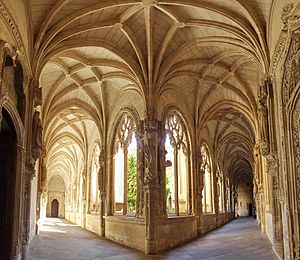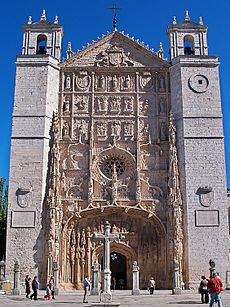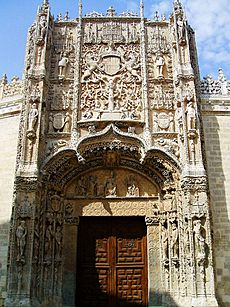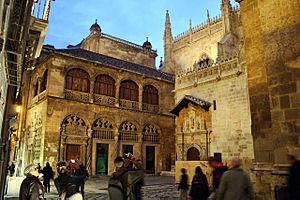Isabelline (architectural style) facts for kids
The Isabelline style is a special kind of architectural style. It is also known as Isabelline Gothic or Castilian late Gothic. This style was very popular in the Crown of Castile (a part of Spain) during the late 1400s and early 1500s.
It was named after Queen Isabella I of Castile, who ruled with King Ferdinand II of Aragon. Together, they were known as the Catholic Monarchs. The Isabelline style shows a mix of older Gothic designs and newer Renaissance ideas. It also includes unique touches from Spain, Flanders (a region in Europe), and Mudéjar art (a style from Spain influenced by Islamic art).
Contents
What is Isabelline Style?
The Isabelline style brought in many building ideas from Spain's traditions. It also used fancy, curvy shapes from Flanders. You can also see some decorations influenced by Mudéjar art. Many buildings in this style were ordered or supported by the Catholic Monarchs.
A similar style called Manueline grew at the same time in Portugal. The easiest way to spot Isabelline buildings is by their many heraldic symbols. These often include the yoke and arrows and the pomegranate. These symbols represented the Catholic Monarchs. You will also often see decorations made of round, bead-like shapes carved from stone or plaster.
After the Catholic Monarchs finished the Reconquista (taking back Spain from the Moors) in 1492, they began exploring the Americas. Spain started to feel very powerful and rich. To show this, they built many grand buildings. Queen Isabella ordered many of these. The Isabelline Gothic style showed how powerful and wealthy the Spanish rulers were. This rich decoration is also part of a wider style called Plateresque.

In Spain, ideas from ancient times in architecture were more about books and stories. In Italy, there were many old Roman buildings. This made "Gothic" mean something different there. The change from the older Spanish Gothic style to the newer Roman (Renaissance) style was slow in Spain.
Gothic buildings used strong ways to build. In Spain, Gothic buildings had smaller windows. This allowed roofs to be less steep. This made a unique and efficient building style. Spanish architects were used to their Gothic methods. They sometimes looked down on Italian architects. Italian buildings often needed metal braces to hold up their arches. Spanish Gothic methods avoided this problem.
The Monastery of San Juan de los Reyes in Toledo is a great example of this mixed style. The architect, Juan Guas, used Gothic ideas more in how he built it. The way the inside space was designed was less like old French Gothic.
In the Isabelline style, decorations from Italian designs mixed with Spanish traditions. These decorations covered the buildings. But the buildings still kept many Gothic parts. These included pinnacles (tall, pointed towers) and pointed arches. Isabelline architects kept using Gothic ways to support heavy vaults. They used flying buttresses to hold up the weight. After 1530, the Isabelline style continued to be used. But Spanish architecture also started to use Renaissance ideas for shapes and structures.
Main Architects
- Juan Guas
- Egas Cueman
- Enrique Egas
- Simón de Colonia
Notable Isabelline Buildings
- Iglesia conventual de San Pablo in Valladolid
- Monastery of San Juan de los Reyes in Toledo
- Royal Chapel of Granada in Granada
- Iglesia de Santa María la Real in Aranda de Duero
- Colegio de San Gregorio in Valladolid
- Monastery of Santo Tomás in Ávila
- Miraflores Charterhouse in Burgos
- Palacio del Infantado in Guadalajara
- Facade of the Palacio de Jabalquinto in Baeza
- Monastery of San Jerónimo el Real in Madrid
- The old Abbey of Santa Engracia of Zaragoza
- Casa del Cordón in Santo Domingo, Dominican Republic
Images for kids
-
View of the Monastery of San Juan de los Reyes in Toledo.
-
Facade of Iglesia de Santa María la Real in Aranda de Duero
-
Cloister designed by Juan Guas in Segovia
-
San Jerónimo el Real in Madrid
See also
 In Spanish: Gótico isabelino para niños
In Spanish: Gótico isabelino para niños
- Spanish Gothic architecture















